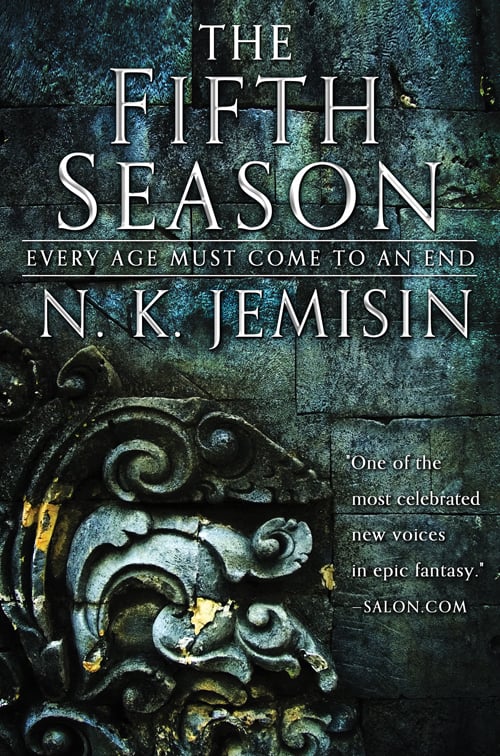Description
“This is the way the world ends. Again.
Three terrible things happen in a single day. Essun, a woman living an ordinary life in a small town, comes home to find that her husband has brutally murdered their son and kidnapped their daughter. Meanwhile, mighty Sanze — the world-spanning empire whose innovations have been civilization’s bedrock for a thousand years — collapses as most of its citizens are murdered to serve a madman’s vengeance. And worst of all, across the heart of the vast continent known as the Stillness, a great red rift has been torn into the heart of the earth, spewing ash enough to darken the sky for years. Or centuries.
Now Essun must pursue the wreckage of her family through a deadly, dying land. Without sunlight, clean water, or arable land, and with limited stockpiles of supplies, there will be war all across the Stillness: a battle royale of nations not for power or territory, but simply for the basic resources necessary to get through the long dark night. Essun does not care if the world falls apart around her. She’ll break it herself, if she must, to save her daughter.” – blurb from the author’s website.
Recommendation
Fans of dystopian fantasy and rich but mysterious worldbuilding will enjoy The Fifth Season. I read The City We Became, another of Jemisin’s novels, and didn’t really like it much, but I enjoyed The Fifth Season enough to pick up the second book. Jemisin plays with point of view, time, and memory in a way that comes together satisfyingly in the end.
Note: the first paragraph of the below discussion directly references and describes a pretty big twist in the book. Experiencing the realization of that twist was what made me want to continue the series, so probably hold off on reading that paragraph if you’re spoiler-averse. I do think the book would still be enjoyable if you know the twist, though, so if that doesn’t bother you, read on.

Discussion
All three of the narrative points of view (Damaya, Syenite, and Essun) being the same person was an excellent twist. In the earlier parts of the book I had a strong preference for the Syenite chapters and was thinking I probably wasn’t interested in continuing with the series since I really only liked ⅓ of the narration. It felt to me like the narration was samey between what I thought were different characters, and that Syen was just more vibrant and well-done than Damaya or Essun.That turned out to be half-true, since Syen is Damaya post-maturing and Essun pre-life-tragedy. It’s a twist that made me feel both a little clever and a little dull for detecting the similarity between POVs but not the reason. The use of second-person narration for the present-day Essun chapters was a clever way to help the reader keep up with the different narrative timelines. I also liked the rate of recurrence of characters from the earlier parts of Essun’s life. It doesn’t feel crowded or heavy-handed since we only see Tonkee/Binof and Alabaster show back up, which is just one character from each of the previous ‘chapters’ of Essun’s life. Schaffa shows up from the Damaya times in the end of the Syenite narrative, but it’s unclear whether he survives.
Speaking of Tonkee/Binof, Jemisin is quite good at casual representation of diverse demographics in race, gender, and relationships. I think Tonkee is one of the best (and only…) examples of a good trans side character. Her transness is important to her background but isn’t her whole purpose or personality. She’s not a token diversity character, and her transness is mentioned in a context that makes sense for the experiences the characters are sharing at that point in the story. The racial representation in the world of the Broken Earth series reminds me of the world of Ursula K. Le Guin’s Earthsea series. Darker-skinned characters are the majority, with lighter-skinned ethnicities mostly living in one or two specific areas of the world. The default assumption in the world of The Fifth Season is not that everyone’s white. I don’t think any of the main characters were white, unless I’m misremembering. There’s also diversity in terms of relationship dynamics. I thought the asymmetrical 3-partner relationship between Syen, Alabaster, and Innon was well done. I don’t think I’ve seen that kind of relationship anywhere else in fiction (or nonfiction for that matter).
Come for the characters and representation, stay for the worldbuilding. There’s a really nice sense of mystery that builds over the course of the novel and creates looming tension that really fits its cyclical world where the population is always aware of the inevitability of the next disaster that will radically shift their way of life. The use of the different temporal perspectives in the narrative is effective for adding layers to the worldbuilding, showing us what the world is like a bit before and during the next cataclysm. We get to see what it’s like to grow up in a rural village comm as a secret orogene, what it’s like to be a trained orogene in a position of simultaneous power and subjugation, and what it’s like to be in hiding. Now that the timelines have coalesced, I’m looking forward to seeing where the second book takes the narrative.
..my only lasting complaint about this book is that I think the cover art is ugly.

Leave a comment